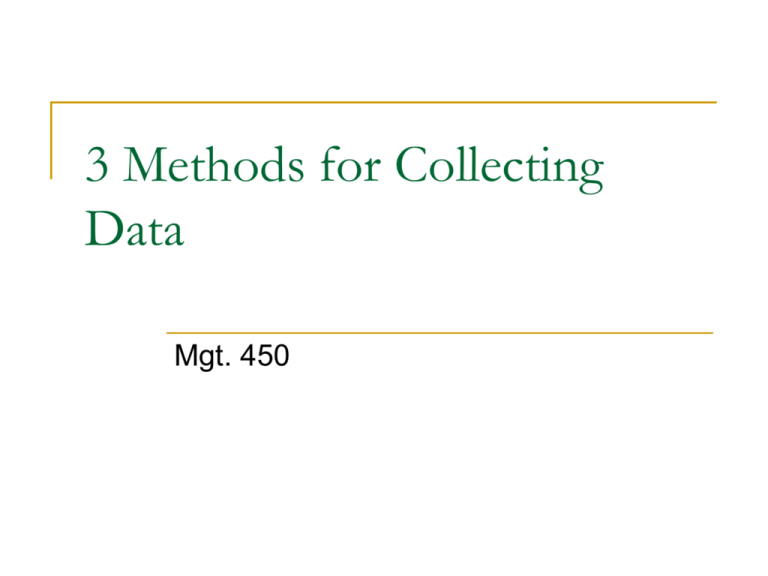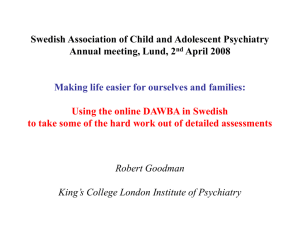Methods for Collecting Data
advertisement

3 Methods for Collecting Data Mgt. 450 Three Major Techniques for Collecting Data: 1. 2. 3. Questionnaires Interviews Observation 2 Using these data gathering methods Each method has advantages and problems. No single method can fully measure the variable important to OD Examples: Questionnaires and surveys are open to self-report biases, such as respondents’ tendency to give socially desirable answers rather than honest opinions. Observations are susceptible to observer biases, such as seeing what one wants to see rather than what is actually there. 3 Use more than one Because of the biases inherent in any data-collection method, it is best to use more than one method when collecting diagnostic data. The data from the different methods can be compared, and if consistent, it is likely the variables are being validly measured. 4 Questionnaires: Questionnaires are one of the most efficient ways to collect data. They contain fixed-response questions about various features of an organization. These on-line or paper-and pencil measures can be administered to large numbers of people simultaneously. They can be analyzed quickly. They can be easily be fed back to employees. Questionnaires can be standard based on common research or they can be customized to meet the specific data gathering need. 5 Questionnaires; there are drawbacks; Responses are limited to the questions asked in the instrument. They provide little opportunity to probe for additional data or ask for points of clarification. They tend to be impersonal. Often elicit response biases – tend to answer in a socially acceptable manner. 6 Sample Employee / Management Relationship Survey Team Goals and Objectives Unclear; diverse; conflicting 1 2 3 4 5 Clear; understood; shared by all. 1 2 3 4 5 Employees are clear about what is expected of them; they know their responsibilities and authority. 1 2 3 4 5 Employees are open and authentic when communicating with management 1 2 3 4 5 Role Clarity Employees are unclear about their roles; responsibilities and authority are ambiguous. Communications Employees are guarded and cautious when communicating with management Decision Making Little opportunity for input; uninvolved; decisions made autonomously. Decisions made jointly through group participation; plenty of opportunity for input; persons affected asked for their opinion. 7 Interviews Interviews are probably the most widely used technique for collecting data in OD. They permit the interviewer to ask the respondent direct questions. Further probing and clarification is possible as the interview proceeds. This flexibility is invaluable for gaining private views and feelings about the organization and exploring new issues that emerge during the interview. 8 Interviews Interviews may be highly structured, resembling questionnaires, or highly unstructured, starting with general questions that allow the respondent to lead the way. Interviews are usually conducted one-to-one but can be carried out in a group. Group interviews save time and allow people to build on other’s responses. Group interviews may, however, inhibit respondent’s answers if trust is an issue. 9 Interviews / Focus Groups Another unstructured group meeting conducted by a manager or a consultant. A small group of 10-15 people is selected representing a larger group of people Group discussion is started by asking general questions and group members are encouraged to discuss their answers in some depth. The richness and validity of this information will depend on the extent that trust exists. 10 Drawback to interviews They can consume a great deal of time if interviewers take full advantage of the opportunity to hear respondents out and change their questions accordingly. Personal biases can also distort the data. The nature of the question and the interactions between the interviewer and the respondent may discourage or encourage certain kinds of responses. It take considerable skill to gather valid data. 11 Sample Interview Questions 1. 2. 3. 4. How do management and non-management employees interact in the office? How do you know when you have done an excellent job? How do non-management employees learn about organizational change? If you could change one or two things about the way management and non-management personnel interact, what would you change? 12 Observations Observing organizational behaviors in their functional settings is one of the most direct ways to collect data. Observation can range from complete participant observation, where the OD practitioner becomes a member of the group under study to a more detached observation using a casually observing and noting occurrences of specific kinds of behaviors. 13 Advantages to Observation: They are free of the biases inherent in the self-report data. They put the practitioner directly in touch with the behaviors in question. They involved real-time data, describing behavior occurring in the present rather than the past. They are adapting in that they can be modified depending on what is being observed. 14 Problems with Observation Difficulties interpreting the meaning underlying the observations. Observers must decide which people to observe; choose time periods, territory and events Failure to attend to these sampling issues can result in a biased sample of data. 15 Observation Protocol A decision needs to be made on what to observe. Example: Observe how managers and employees interact in the office. Observe who has lunch with whom. (Do managers and non-managers eat together? Do executives have a private lunch area?) 16


